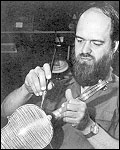Keith Hill offers this insight: “I am an aesthetic scientist. Aesthetic science is the ‘scienta’ in the motto Ars nihil sine scienta est. My work is a reflection of my aesthetic science, in other words, it reflects the attention I pay to how I hear, what I hear, how I see, what I see, how I sense, what I sense, and how and what intuitions arise from such attention. I use harpsichord, fortepiano, violin, and guitar making as well as my music, painting, and decoration to express the principles of aesthetics as I understand them from my experience paying attention. Even the fifty chickens, twenty geese, thirty-six ducks, and eight cats I keep are subjects for my aesthetic study.”
▪ bio current as of 2001

